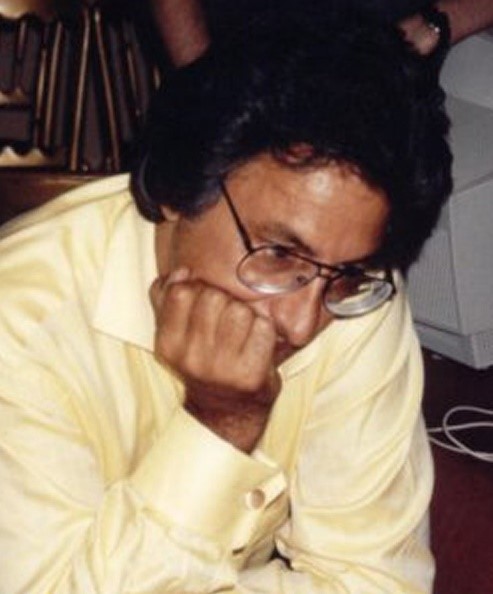This week, we join another new event, the Alt Swiss IMP Teams-Pairs. This is effectively IMP Pairs, where results in head-to-head matches are compared to a datum result, calculated by dropping the top and bottom scores and averaging the remaining results on the board. The main difference is that each ‘pair’ consists of a team of between two and ten players, with any two playing in each match. A total of 22 teams lined up for a 13-round Swiss event of 10-board matches.
As usual, we start with some problems for you to consider. We will find out later how your choices would have worked out. First, with just the opponents vulnerable, you hold this hand in the West seat:
What action do you take?
Secondly, with both sides vulnerable, you hold as North:
What action do you take?
Finally, with both sides vulnerable you are South with these cards:
What do you bid?
While you consider those problems, we begin with action from Round 1, which produced the first of the bidding problems posed above.
Stewart Rubenstein’s Dutch opponents provided little assistance, with Victor Oranje’s well-judged silence offering West no clue that there might be a club void opposite. Perhaps Blackwood might have solved the problem, but it is hard to be overly critical of Ruth Fleischmann’s practical jump to Six Hearts. There was little to the play, and declarer quickly claimed all 13 tricks: E/W +1010 but only a 1-IMP loss for team PARKER as the datum on the deal was an unexpectedly-low E/W +1040.
Janice Seamon Molson was faced with a slightly different problem: Sylvia Shi had overcalled only at the three-level but Poland’s Marcin Lesniewski had increased his partner’s pre-empt to the five-level, despite the adverse vulnerability. Molson advanced with Five Diamonds, but Shi’s raise to the small slam failed to get the job done. Should Shi perhaps have cue-bid 6♣ on the way and, if so, would Molson then have had enough to bid the grand? E/W +940 and a 3-IMP loss for team SEAMON-MOLSON.
Only two of the 22 East/West pairs solved the conundrum, which is why the datum score was so low.

This was Germany/England vs USA/Sweden. Phil King ploughed a middle ground between passing and a jump to the five-level in clubs, but his gentle 4♣ bid allowed Gary Gottlieb to jump to 5♥ . Such a jump would usually be asking specifically for a club control, but that’s clearly not how Gottlieb intended it on this hand. Even so, Peter Fredin advanced with a 6♣ cue-bid, showing first-round control of that suit. Now Gottlieb made a grand slam try with 6♦ . Quite rightly, Fredin concluded that whatever his partner was looking for, he had it. Well bid: E/W +1510 and 10 IMPs to team FREDIN-GOTTLIEB, whose 32-14 win was enough to see them atop the table after the first match.
Mozambique’s Christian Lahrmann chose not to pre-empt on his 2-2-2-7 shape at red, allowing the Egyptian/Georgian combination to start their auction at the one-level. Ahmed Soliman agreed diamonds with a 4♣ cue-bid and then jumped to 6♣ at his next turn. That was enough for David Chechelashvili to accept the grand slam try. E/W +1440 and 9 IMPs to team CHECHALASHVILI-SOLIMAN
The second of this week’s bidding problems came from this deal in Round 2, which created a swing in every match.
Let’s start at Table 1, where FREDIN-GOTTLIEB were up against the primarily-Dutch team, IMP.
Peter Fredin’s decision to rebid 1NT may look a little strange with 5-card support for the suit his partner has shown, but showing this hand as something like 19-21 balanced was presumably the objective when North doubled the One Diamond opening. Does partner’s One Spade response necessarily change things? Indeed, it is hard to be critical of an action that gets you to a game that will make better than 95% of the time.
Ed Hoogenkamp led the six of diamonds (and anyone who leads ‘top of nothing should note what a disaster leading the nine would be on this diamond layout). Unfortunately for the USA/Swedish combination, declarer soon discovered that this deal fell into the 5% when spades were 4-0 offside. Declarer’s nine top tricks had suddenly become only seven. N/S -200, and with the datum score N/S +380, that was 11 IMPs to team IMP, who won a closely fought contest 22-18.
This time it was the Dutch on the receiving end of misfortune. Jan van Cleef advanced with a strength-showing cue-bid at his second turn. When Marina Witvliet showed some values with 2NT, van Cleef also headed for the nine-trick game. Lesniewski could not lead a diamond from his side of the table, but his ♥ Q opening gave nothing away and declarer was a trick short when spades failed to produce the expected five tricks. N/S -100 and 10 IMPs to SELIGMAN.
Not that game in spades was necessarily straightforward.

Zia got the defence off to the best start when he opened the ♥ Q against Four Spades. Kees Rentes won in dummy to cash a high trump. When West discarded, Rentes immediately set about establishing his clubs. Zia had bid the suit, so East was known to hold a singleton, but declarer gambled that it would be an honour and cashed the ♣A. When East produced the ♣ 6, declarer was in trouble. He continued with the ♣ 9 from dummy, but Zia won with the ♣ 10, cashed the ♣ K and continued with the ♣ Q, ensuring a third minor-suit trick for the defence, as declarer now had nowhere to pitch the second diamond loser from dummy. N/S -100 and 10 IMPs to GUPTA
SELIGMAN won 28-5 and GUPTA 32-9, so two teams who had started amongst the favourites were now back above average after making losing starts.
All of the other West players led the ♣ K against Four Spades, which gave declarer the timing to set up the clubs in his hand in time to avoid a diamond loser. Indeed, the only North to declare Four Spades, also avoided the diamond lead that would have legitimately defeated the contract, East choosing to lead his singleton club rather than the suit his partner had bid. That meant a 6-IMP gain for the North/South pairs scoring +620.
After two matches, the USA/Italian combination of Ruth Fleischmann and Mustafa Cem Tokay topped the table, narrowly ahead of REYNOLDS (Netherlands), DONNER (USA/Sweden) and IMP (Netherlands/Poland).
Because there is no satisfactory solution playing standard methods, this week’s third bidding problem is considered something of an old chestnut in bidding challenges. As it demonstrated in Round 3, though, it is still quite capable of creating swings in the real world too.
Both Vul. Dealer South
It was IMP vs DONNER at Table 2
Do you rebid your diamonds or raise partner’s hearts? If you do rebid the diamonds, at what level? For the Dutch, Gerard Sprinkhuizen chose to rebid only Two Diamonds. Onno Eskes had no reason to take another bid on the North hand and, when the defence began with two rounds of clubs, declarer made twelve tricks in his two-level contract. N/S +170 but, perhaps surprisingly, only a 2-IMP loss for team IMP as the datum score on the deal was just N/S +240.
A couple of East players entered the auction with an ill-advised takeout double, allowing South to start with a support double, and thus the heart fit at those tables was easily found. English team IMPS-R-US demonstrated the way to deal with this combination without help from their Dutch opponents:

Warner Solomon raised hearts at his second turn, which often turns out to be the better option on this hand type. Remember, when you have extra values, partner is much more likely to be enthused by a raise of his suit than to hear you rebidding his singleton. N/S +680 and 10 IMPs to IMPS-R-US.
At Table 1, South opted for the third option, a jump rebid in diamonds. So that got her side to game, presumably…
Yes… and no. Ruth Fleischmann got her side to game, but not in the optimum contract. Tom Reynolds led his longest suit against 3NT and the defence cashed the first five tricks before switching to a spade through dummy’s queen. By the time declarer gained the lead, there were only five tricks left. N/S -400 and 12 IMPs to REYNOLDS.
An emphatic 46-9 victory for DONNER moved them to the top of the leaderboard after three matches. They leapfrogged over both of the team ahead of them, who played out a 31-30 match, edging REYNOLDS ahead of FLEISCHMANN-TOKAY into second place.
High-level competitive deals often generate significant swings. It is important to keep going as high as you dare, but the art is to stop bidding when you have reached your limit. Let’s take a look at this merry-go-round to see who spotted the right time to step off…
Looking at the diagram, you can see that each side has two suits, one major and one minor. Both sides can make ten tricks in either of their suits: North/South lose one spade, one heart and one club playing in either diamonds or spades, whilst East/West lose a diamond and a trick in each major playing in either clubs or hearts.
We start at Table 2:
Ruth Fleischmann’s takeout double showed her two suits, but that is the same call you would make on a hand that was stronger in terms of high cards but less distributional. Although he had a fit in both suits, Mustafa Tokay only jumped invitationally to Three Hearts over Molson’s support-showing redouble, and thereafter he decided that he had shown his hand. As a consequence, Janice Molson was allowed to play peacefully in Four Spades. N/S +620 was worth 11 IMPs to SEAMON-MOLSON when the datum score on the deal was only N/S +100.
The Dutch pair at the top table appear to have escaped a possible misunderstanding on this deal:
Sandra Rimstedt’s 1♦ opening was alerted as possibly showing only 2+ diamonds. At his first turn, Victor Orange overcalled 2♠ (which for most partnerships would be natural), but the Dutch were clearly on the same wavelength in terms of knowing that it showed a two-suited hand. However, West self-alerted his bid as showing hearts and a minor. Perhaps not having noticed that North’s opening had been alerted as possibly short, or perhaps just thinking that his partner’s bid showed specifically hearts and clubs, Arjan Roelofs jumped to Five Clubs. Fortunately for the Dutch, West’s second suit was clubs, so no harm was done. Indeed, the nebulous nature of North’s opening bid combined with the level of West’s intervention and East’s subsequent pre-empt meant that South never found out that his side had a fit in either of his suits, so the Dutch were allowed to play unmolested. The defenders duly scored their three tricks: N/S +50 and 2 IMPs to REYNOLDS.
IMPs went back and forth from one pair to the other with great regularity at our final table:
The auction began normally enough and, here too, West had a way to show a two-suited hand. North made a support double, showing three spades, and Yaniv Zack jumped all the way to game in hearts. Undeterred, Christ Parked bid the obvious Four Spades, which trundled back around to East, and then the fun began.
Zack correctly judged that Five Clubs would be a cheap option for his side. Not content with a small plus, and knowing his side had a big double fit, it is hard to criticize Parker for soldiering on to Five Diamonds. Now everyone was guessing: Nathalie Saada took her side’s plus score and promptly turned it into a minus, only for Anam Tebha to do exactly the same thing in reverse. No one doubled, so the upshot was just N/S -50 and 5 IMPs to ISRAEL.
The leaderboard was now beginning to take shape. These were the standings with four matches played:
| DONNER | 56.35 VPs |
| SEAMON_MOSLON | 50.47 |
| REYNOLDS | 50.22 |
| SELIGMAN | 50.05 |
| FREDIN-GOTTLIEB | 49.59 |
| FLEISCHMANN-TOKAY | 47.35 |
Gary Donner and the Rimstedts have opened a small lead at the top, and then there is barely a cigarette paper between the handful of teams in the chasing pack.
Of course, there is plenty of troubled bridge to go over the water before we can crown a winner here, and we shall be back next week to bring you the action as the plot thickens.
